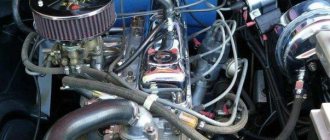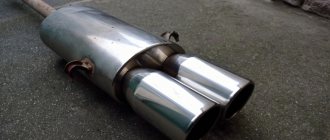VAZ cars, despite their age, are still popular among car enthusiasts. Based on the number of shortcomings of domestic cars, owners are forced to resort to improvement and modernization of certain elements of vehicles. This article will talk about tuning the VAZ-2107 stove, since it is the weak link of the vehicle.
It often happens that the standard VAZ 2107 stove cannot cope with severe frosts
Everyone knows how important the heating system of a car is for the comfort of the driver and passengers during cold winter periods. Freezing windows and cold in the car create great discomfort. Let's look at the main options for improving the vehicle's stove.
You can improve the operation of the heating system on the “seven” in the following ways:
- redo side window ventilation;
- modernize the damper;
- modify the foot airflow system to increase its efficiency;
- improve the operation of the rear cabin heating system;
- modify the thermostat;
- improve the functioning of the steam exhaust line;
- install an additional water pump.
User Egor Panther spoke about options for upgrading the heating system in VAZ 2107 cars.
Improved side ventilation
The side ventilation system needs to be modified after purchasing an additional fan. The device is mounted in the left line, which will allow forced air flow to the deflector.
The tuning procedure looks like this:
- At the first stage, the deflector device is dismantled from the main line. To perform this task you need to use a screwdriver. The deflector in the cabin is pryed up and removed; it must be pulled forward. Similar actions are performed on the other side of the stove.
- Dismantling the device is carried out carefully so as not to leave any traces of damage on the center console.
- If the deflector is removed, it is necessary to remove the holding device from the dashboard. This element is mounted in the center console using special antennae. The essence of this modernization is that a classic computer fan is installed to force air flow into the heating system.
- To install the ventilation device, the element must first be fitted to the deflector body. After applying it to the plastic with a marker or pencil, you need to apply markings. Using a utility knife, a cut is made in the plastic on the deflector.
- If the dimensions are marked accurately, the ventilation device will be tightly installed in the housing. This is important, since such installation will prevent the part from loosening while driving.
- After completing the installation of the fan, you need to make sure that its blades rotate normally and nothing interferes with them. If problems arise, the device is adjusted. If necessary, the blades can be trimmed a little.
- To ensure efficient air flow and no backdraft, the entire structure must be sealed. Therefore, using sealant or the remains of plastic that appeared after cutting the deflector, the cracks are clogged.
- If all steps are completed, the ventilation device is installed in the main line area, and then mounted on the body of the deflector element.
- After completing all the installation steps, you need to work with the electrical component. It is recommended to connect the fan electrical circuit to the conductor where the current appears when the ignition is activated. This option is more convenient. It is possible to connect the device to the heating unit control cable.
Damper modernization
Modification of the VAZ 2107 stove, which consists of upgrading the lower damper of the system, is the easiest option to implement. If all actions are performed correctly, the device will not open or close randomly when the car drives over bumps. This will ensure efficient and equal airflow on both glasses.
The upgrade procedure is carried out as follows:
- It is necessary to visually evaluate the housing of the heating unit. In its corner there is a hole of the required diameter to carry out the work. If it is not there, then it is drilled. For this, a drill with a diameter of 6 mm is used.
- A bolt is installed into the hole made from the inside. The valve itself closes.
- After this, using the same drill, a hole is drilled directly into the handle of the device. It is necessary to drill so that the hole is located at the level of the bolt installed earlier. In this case, the length of the screw must be such that when lifting the damper, the element can freely fit into the hole made.
- If everything is done correctly, the bolt is tightened with a nut. It is recommended to use a black part, then it will be difficult to see.
User Nail Poroshin spoke about the features of modifying the air damper thrust.
Rear seat heating system upgrade
To modernize the rear seat heating system, you will need to install an additional “snail”, which can be used from the VAZ 2108:
- First you need to make a housing to fix the “snail”. To perform this task, you need to cut plexiglass.
- Using a regular hairdryer, you need to carefully make bends on the glass so that it turns out as shown in the photo.
- Then, using a hair dryer, you need to carefully change the shape of the case. It is necessary to act carefully, otherwise the “snail” may not fit into the landing site.
- When completing the task, you can remove the device plug using a utility knife. This will reduce the dimensions of the part by approximately 3 cm.
- Then the side walls of the structure are manufactured. For this you can use duralumin or other similar material. The wall thickness should be 1.5 mm.
- The next step is to remove all the cracks. To do this, the joints of the device must be sealed using adhesive-sealant or other means.
- Then you need to work with the channels through which air will flow to the blower openings. It is recommended to make these elements collapsible. For manufacturing it is desirable to use a similar material.
- In order to reduce the amount of resistance and remove turbulence, the turns of the air channels must be smooth. They can be made from duralumin.
- At the next stage, we need to build slots that will be used to warm the feet. We are talking about front airflow - for the driver and passenger. The slots must be equipped with shutters. You can additionally install a variable resistor device, which will be used to regulate the speed of the electric motor. This element can be used instead of a resistor designed to change the brightness of the backlight.
- The main stage in this modernization is the construction of a system for effectively heating the feet of passengers sitting in the rear. To do this, it is necessary to additionally install several longer pipes. The radiator device is quite powerful and its power will be enough to supply air flow back. All connecting points of lines and blowers are sealed to prevent leakage of warm air flow.
Using a hair dryer, a body for the “snail” is made from plexiglass
Removing the snail plug
Modernization of the housing for the production of air channels
We recommend: Replacing the thermostat on the Lada Priora (16 valves)
Improved foot airflow efficiency
To improve the efficiency of blowing the legs, you will need to replace the standard fan with another; you can use a device from a VAZ 2108.
The upgrade procedure is performed as follows:
- The first stage is performed inside the car. It is necessary to dismantle the lower part of the heating unit. A standard ventilation device is installed here.
- The fan is being dismantled. It will no longer be needed and can be recycled.
- Next, the plastic ridge is cut, which supplies the air flow to the floor of the machine. On “eight” units, the fan motor is larger in size.
- A ventilation device equipped with two blades is dismantled. A knot with five elements will be used instead. Before installing a new device, it is necessary to diagnose the quality of its operation. To do this, the node is connected and checked.
- If the device works correctly, then it is installed instead of the old one. After installation, the unit must be properly fixed. This will prevent the negative impact of vibrations during movements and rapid failure of the device.
- In order for the ventilation unit to function more smoothly, it is necessary to replace the resistor element. This is due to the fact that the device allows for a larger volume of air flow and operates noisier. Therefore, a resistor element is installed, which can be used from a VAZ 2108.
- The buttons, as well as the control components of the ventilation device, must be replaced with new ones. It is allowed to use parts from the VAZ 2108. The standard key from the “seven” is suitable in size and mounting. But it quickly fails as a result of a large difference in current. At this stage, the modernization procedure can be considered complete.
Modification of the thermostat
Thermostat from a Chevrolet Niva car
The procedure for modifying the thermostat on a VAZ 2107 involves replacing the standard device with a part from a Chevrolet Niva:
- First, the refrigerant from the cooling system is drained. The car engine warms up, a container is placed under the heater tap and the liquid is drained.
- The engine compartment is opened, the thermostat with the lines connected to it is dismantled. It is necessary to disconnect the outlet pipe located at the bottom; it goes from the radiator device to the element being replaced. The bypass line is disconnected; it is installed on top, as well as the hose going from the thermostat to the pump. The condition of these pipes is assessed. If they are worn out or damaged, then new ones must be prepared.
- The refrigerant outlet pipe and the copper pipe are disconnected. The last element is unscrewed from the pump; to do this, you need to unscrew two nuts and remove the flange from the studs.
- The lower removed line is taken and the middle part is cut out of it. The length of the segment should be about 7-9 cm.
- A new thermostat device is being installed. Its connection is made using a pipe with a water pump. The hose must be slightly bent in advance.
- Then a thick pipe from a VAZ 2108 is taken and adjusted to the place where the lower standard hose was installed. You need to cut off identical parts from both ends of the element and connect it to a new device. In principle, it is also possible to install a standard line, but this option is simpler.
- The upper hose is being installed; we are talking about a standard pipe.
- Instead of the dismantled line, a plug is made; it went from the heating unit to the water pump. To do this, you will need a copper tube; a connecting flange is soldered off from it. A sealing element is made from rubber, then the surface of the pipe is treated with sealant. The structure is screwed back to the water pump.
- The next step is to connect the pipe that removes the refrigerant from the heating device with the inlet on the thermostat. To complete the task, take a dismantled copper hose, remove the excess part, then bend it a little.
- A bracket is made that will be used to fix the pipe to the exhaust manifold device.
- The outlet line from the heating unit with the hose, which was previously disconnected, is connected. The output from the stove remains the same, but the input will go not to the pump, but to the thermostat.
- The end of the line with the corresponding input is connected to the thermostat device; this will require a shorter and curved pipe. It is used to remove refrigerant from the cylinder head to the heating unit. This element must be adjusted to length in advance. Difficulties may arise when using an aluminum thermostat because the walls of such devices are thicker. This means that the line must be used with a large diameter.
- The thin pipe of the heating system of the intake manifold is fixed to the thinnest outlet of the thermostat. First you need to disconnect the end going to the lower line from the heating device to the water pump. The pipe is measured and, if necessary, the excess part is sawed off. The connection point is treated with sealant. To prevent leakage, the volume of glue must be large.
- Then the junction of the pipes and the thermostat is tightened using clamps. Refrigerant is added to the heating system. The engine is started. If an air lock has formed in the system, it must be removed.
We recommend: Canister solenoid valve - where is it used?
Valery Imenov spoke in detail about installing a thermostat from a Lada Granta car on classic VAZ models.
Installing an additional pump
Installing another pump on the heating unit will provide better heating of the car interior. Typically this device is installed next to the battery and pipes in the engine compartment. When performing the task, it is necessary to dismantle one line coming from the cylinder block. This pipe is connected to an additional pump. From the cylinder block, the line should go to the front of the water pump, and the outlet pipe will connect to the heating system.
The power supply to the auxiliary pump is taken from the activation key for the rear window heating system. This will allow the device to turn on together with this node. There is one positive conductor coming from the electric motor of the additional water pump. The negative contact is the mass of the device.
To provide power to the pump, do the following:
- The first connector with conductors is dismantled. Several electrical circuits are connected to it. The gray conductor is designed to activate the rear window heating system; this is the main cable.
- The power cable from the water pump is connected through this wire. The cable itself is led out into the engine compartment through a technological hole.
- For better fixation of the conductor, it is recommended to solder the contact element.
- Once the pad installation is complete, the auxiliary water pump is ready for testing and operation.
The Avtopodogrev channel spoke about the installation and features of connecting an additional pump on classic VAZ models.
If necessary, connecting the water device can be done using another method:
- To complete the task, you will need a block from the injectors or a detonation controller. This item can be purchased at any auto store.
- Two conductors are soldered to the ends of the block, and then the cables are installed in a corrugation and wrapped with electrical tape.
- Then an electrical circuit is drawn out to connect the ground; you can use any conductor available on the bracket near the installation site.
- The harness itself is installed upward, the resistor elements of the heating unit are connected to the connector where the positive contact was taken. This will automatically activate the water pump, which draws about 1.5 amps during operation. This connection method allows you not to use additional relays and connect directly to the positive output in the connector.
Many car owners install not “VAZ” pumps, but “foreign-made” pumps on their cars. You can use device model 0392020034 from the manufacturer BOSCH. The productivity of such a pump is 750 liters per hour, but additionally you need to purchase clamps, as well as about 10 meters of corrugation. Before performing the task, be sure to drain the refrigerant from the system.
The difficulty of installing a branded water pump is that the diameters of the hose and fittings of the device do not match. The first is 1.6 cm, and on the pump - 2 cm. Therefore, it is recommended to use more elastic hoses. This will allow you to tighten the line onto the fitting. For better passage, the element can be treated with motor fluid.
Tuning the VAZ 2107 stove
The VAZ 2107 stove is located in the cabin and is attached to the partition of the power unit compartment with four studs. The place where the stove connects to the body is sealed. The stove kit includes a fan casing, a radiator casing (with an air supply cover), and a fan casing (with an air distributor cover).
If necessary, the supplied air is heated by a liquid radiator. The latter is equipped with pipes for air supply and exhaust. They are supplied to the engine cooling system. A fan is mounted directly under the radiator. The electric motor, equipped with an impeller, is mounted on two elastic pads. The fan can operate in two speed modes. A special switch is located on the central panel.
Using deflectors, air is directed not only into the car interior, but also onto the side and windshields. Despite the fact that everything seems to be well thought out, the standard stove of the VAZ 2107 causes a lot of complaints among car enthusiasts. Among the main problems that owners of “Sevens” face are the following:
- weak airflow in the side deflectors;
- lack of airflow and heating for rear passengers;
- insufficient air flow;
- noise when the stove is operating.
And this is not the entire list of problems that owners of this model face. Some experts recommend installing a stove from the eighth model (while leaving the original impeller). But such manipulations can only partially solve the problem. You will only be able to achieve a slight improvement in the air flow into the cabin. At the same time, the noise will also increase.
In general, this is not a very suitable option. Therefore, we recommend making changes to the standard “Seven” stove (by installing a complete volute). Also, we advise you to modify the lower part of the stove in order to accommodate the snail and obtain a more uniform flow in different directions.
Content
Despite a decent number of shortcomings, VAZs remain loved by our compatriots. Today, we will tell you how to improve the operation of the stove on the classic. The heater and ventilation provide a favorable atmosphere inside the car. In the VAZ 2107, air is supplied from the street. Air, through gaps in the hood of the car, enters the inside of the car. At the same time, depending on the setting, it heats up or cools down.
The air intake box is located in the rear part of the engine block; the air is purified from moisture. The box is protected from the engine by special (rubber) gaskets. Moisture comes out, and the air flow enters the heating system. The gaps in the box are closed with a special partition (lid). When driving, part of the air flow exits through devices located above the dashboard.
Do-it-yourself modification of the VAZ 2107 stove - step-by-step photo report
1. The first step is to make a housing for attaching the snail. To do this, you need to cut plexiglass.
2. Using a hair dryer, carefully bend it to get this shape.
3. During the work, the “snail” plug was cut down in order to reduce the dimensions of the structure by about 3 cm.
4. I decided to make the side walls from 1.5 mm thick duralumin.
5. I recommend sealing all cracks and joints of the structure with silicone sealant or a similar sealing substance.
6. The most difficult thing, in my opinion, is working with the channels for supplying air flow to the air duct openings. It was decided to make them collapsible from the same material.
7. To reduce resistance and remove turbulence, I made smooth turns from duralumin.
8. Next, slots were made to air the driver's and passenger's feet with flaps.
9. An optional item, but I still decided to do it for myself - I installed a variable resistor for adjusting the speed of the cochlea instead of the backlight brightness resistor.
Now about the results of modification of the VAZ 2107 stove.
Everything turned out even better than I expected. The stove operates at low speeds completely silently, the air flow from the side slots is quite decent despite the multiple turbulences and bends of the structure. There is a uniform flow of air in all directions, which quickly and gently warms up the entire cabin. At the second and third speeds, the flow is simply “crazy”, so I turn it on only in case of emergency, for example, when I need to quickly warm up. Moreover, I noticed that after upgrading the stove, the unpleasant effect called glass fogging disappeared, and the car was dry and comfortable.
If you know other ways to improve the VAZ stove, write about it in your comments to the post. Thank you for your attention, good luck with your tuning!
Other interesting articles on the topic of tuning:
The fastest and most cost-effective upgrade is installing coolers
The standard heater of the VAZ 2105 does not always cope with cold winter weather
Do-it-yourself modification of the VAZ-2105 stove will not require too much labor and money if the car owner decides to modify the standard equipment by installing coolers on the side deflectors. It is worth noting that absolutely everyone should improve the heating equipment of the VAZ-2105, since due to the irrational design, all the air entering the cabin goes down. Thanks to the installation of coolers, which are usually included with PCs, you can adjust the air flow going to the sides. Experts recommend purchasing devices that can make at least 1500 revolutions per minute. Despite the fact that the modification made to the VAZ-2105 stove will not require much expense and time, it will help increase the level of comfort.
Heater modernization
Every car owner knows that on a VAZ 2107, replacing the heater may be due to its poor performance. But not everyone decides to change the heater - most owners of the “Seven” decide to disassemble, repair, tune and remake the heater as a whole. There are many schemes for tuning and repair, but you need to take into account that it is not so easy to implement them at home. Without any problems, you can seal the joints of the system lines with nozzles with your own hands, and also redistribute the air flows according to need (the author of the video is VAZ 2101-2107 REPAIR AND MAINTENANCE).
How the heater of the VAZ “Seven” is modified
First you will need to completely disassemble the stove, cutting off all the protruding parts at the bottom of the body, since you will no longer need them.
To install the “snail” in a new location, you must first make the case, using polycarbonate or plastic for its base. This is not difficult to do if you have the necessary tools. It is enough to cut pieces of plastic to the size of the “snail” and connect them together and, after adjusting to size, fix it on the lower part of the stove body. If you have a plastic container or similar polycarbonate container the size of the snail, you can use that, but first make sure it can withstand the heat. The snail should fit firmly into the manufactured housing, without protruding too much beyond the radiator stops.
It is very important to maintain the proportions of the new part in the heater, because if the size of the cochlea body is increased, the stove may not return to its proper place, and you will have to start all over again. Once you're sure you've got the proportions right and the body size is the right size, you can seal the joints of the new body with sealant.
Improvement by replacing the fan
Since the radiator in a VAZ gives off a sufficient amount of heat, poor interior heating is associated with deficiencies in the fan. Simply put, there is not enough air to heat the entire interior of the car.
To solve this problem, it is worth replacing your fan, which is too small and not productive, with a better fan - from a VAZ-2108 or VAZ-2109, which have a higher rotation speed.
Refinement of the VAZ-2101 stove is carried out in several steps.
Step-by-step instruction
- In the cabin, we remove the shell of the lower part of the heating, where the fan is located.
- We remove, in fact, the fan, which we will no longer need.
- If you install a part from a figure eight, you need to cut the ridge that supplies air to the floor of the car.
- We remove the fan with two blades, since a fan with five blades will work instead.
- Don’t forget to check the new fan before installation - connect it and see if the blades move and there is air flow.
- We fix the new device instead of the old one and securely fasten the entire structure.
- Along with the fan, it is worth reinstalling the resistor, buttons and regulators - we also take them from the figure eight. This must be done, since due to the difference in currents the elements will quickly become unusable.
Tuning the VAZ-2101 stove, based on replacing the fan and other elements, although it will not make the stove work quieter, will allow it to heat the interior faster and better.
Let's sum it up
As you can see, even taking into account the simplicity of the design, repairing the VAZ 2107 stove can be a labor-intensive procedure due to difficult access to certain elements of the heating system.
Moreover, if such a need arises, modification and tuning of the VAZ stove, as well as maintenance and replacement of the VAZ 2107 heater with your own hands can be done independently in the conditions of an ordinary garage.
There is air in the engine cooling system: symptoms of airing, reasons for the formation of an air lock. How to bleed the engine cooling system.
Antifreeze boils and bubbles in the expansion tank. Causes of antifreeze or antifreeze boiling, main faults, troubleshooting, recommendations.
Reasons why coolant starts to leak. How to find the location of an antifreeze or antifreeze leak yourself. Useful tips and tricks.
Causes of air in the car engine cooling system and symptoms. How to remove an air lock from the cooling system, tips and tricks.
Problems with stove dampers and their modernization
Another problem with the VAZ 2114 stove is the operation of the dampers. In the car, their position is regulated by three more cables. They also tend to become loose and malfunction over time. An indicator of a violation of their adjustment is the fact that hot air comes only from the central air duct, while cold air goes to the passenger seats and to the front window heater.
Adjustment of these cables is carried out similarly to the cable of the stove faucet. When the slider is moved to the extreme right, the dampers should be fully open.
If you plan to adjust the heater while replacing the radiator, you should also pay attention to the condition of the dampers themselves. If they are not airtight, they should be glued with foam rubber or any other insulation. Any leaks lead to the dilution of the hot air flow with cold air and, as a result, to a deterioration in the operation of the stove.
Correct modification of the left deflector
The left deflector (driver's) is located farthest from the hot air entry point. As a result, all losses affect him more than anything else. It also happens that there is warm air everywhere except it. Naturally, the driver will not like this much, especially if he usually drives alone in the car.
To improve the heating system and provide the driver's air duct with a sufficient flow of warm air, an additional fan is installed in it.
A computer processor cooling fan is ideal for this purpose (it can be bought at any computer store, it costs about 500 rubles). They come in different sizes and power, choose the right one based on the supply on the market. Or if there is an old computer somewhere in the garage, take it from there - it will do.
The order is:
- Pull out the deflector.
- Prepare a hole for installing the cooler.
- Prepare the wiring. If an additional pump is installed in the system, it is worth installing the power supply through the same switch. You can make a separate switch or, as a last resort, connect it from the ignition. It will turn on automatically when the engine starts.
- It is important to completely seal the remaining holes, otherwise the expected result will not be obtained.
By performing all these manipulations, you can achieve restoration or even significant improvement in the operation of the stove. If your work involves constantly moving around the city by car, these measures are simply mandatory.
Types of additional heaters
There are three types of additional heaters for the VAZ-2107, and each of them has its own characteristics. The interior of this car can be equipped with:
- electric heater;
- autonomous heater;
- additional stove radiator.
Which one to give preference is up to the car owner to decide, and here consider the positive and negative sides of each option. Electric heaters are a heater with a fan, adjusted to operate from a 12 V network. The main advantage is ease of installation, since they just need to be connected to the on-board network through the cigarette lighter or run the wiring directly to the battery.
The negative qualities of electric heaters include low power and heavy load on the on-board network. You should not expect a significant increase in the temperature in the cabin; it is suitable for intensive heating of glass, since it is not recommended to use it for a long time.
Self-contained stoves include an internal combustion engine and a fan installed in a housing. The essence of its work is that the internal combustion engine (ICE) heats up during operation, and the generated heat is supplied to the passenger compartment by a fan. And since the heating of the internal combustion engine is strong, such an additional stove is effective. The positive qualities of such a heater include autonomy; it works even when the car’s engine is turned off. The negative side of an autonomous stove is increased noise and additional fuel consumption.
One of the best options is to use an additional radiator installed inside the car, which is connected to the engine cooling system. Such an additional stove does not require fuel and creates a slight load on the on-board network, while installing another heat exchanger allows you to increase the temperature in the cabin. The disadvantage is the complexity of installation.
To make the stove heat better...
Many motorists decide to tune the VAZ-2105 heater only because in the cold season, travel becomes uncomfortable, the driver and passengers feel cool, and the heating device cannot heat the interior at a decent level. Modernizing the VAZ-2105 stove helps solve all of the above problems.
It is necessary to replace the resistor to switch speed modes because the volume of incoming air depends on it. At the same time, the switch that controls the rotation of the fan should be replaced. As practice shows, a stationary device is not capable of passing a large air flow, as a result of which it melts and, accordingly, becomes unusable.
Having come across an article on the Internet about modifications to the VAZ 2107 heater, I decided to write a short post.
Get to the point. Even earlier, I came across an article about improving the interior heating of VAZ 2107 - 2105, where the emphasis was placed on significant sealing of all connections in order to avoid loss of air flow. This option will partially give results, but not always.
I want to write about improving the air supply source - the fan. The stove radiator itself is capable of giving off quite a lot of heat, there is simply not enough air flow. To solve this problem, it was decided to use a fan motor. For comparison:
- The standard VAZ stove fan motor of classic models is 3000±150 rpm with a current consumption of 4.5 A.
- On the “chisels” we see the following characteristics - 4100±200 rpm, with a current consumption of 14 A!
As you can see, the current consumption is not childish, but the air flow will be stronger. For maximum effect, a five-blade fan is also used. What was done first? Let's look at the photo:
To begin with, of course, everything was dismantled and dismantled. The comb (1) was cut off and the fan speed control resistor was replaced. Why was this partition cut down? The fact is that when installing an electric motor from a VAZ 2108, a difficulty arises, which is due to the large dimensions of the engine from the “chisels”. And in order to completely close the heating of the feet, it must be removed.
According to the author’s calculations, the result should be almost 2 times more air.
vaz-lada-2107-1439.jpg
Details of the ventilation and heating system of the VAZ 2107 car 1 - left air duct for heating the side window; 2 — air duct for heating the windshield; 3 — heater radiator casing; 4 — air supply cover; 5 — heater radiator; 6 — heater tap; 7 — radiator outlet pipe; 8 — radiator inlet pipe; 9 — right air duct for heating the side window; 10 — deflector; 11 — air duct damper; 12 — air distribution cover; 13 — fan guide casing; 14 — heater fan; 15 — lever of the air distribution cover; 16 — heater fan casing; 17 — control rods; 18 — bracket for control levers; 19 - central air duct
Among the main malfunctions of the VAZ 2107 heating system:
- leakage of the radiator, tap, pipes or connections between them;
- malfunction of the switch for the available operating modes of the electric fan,
- damage to the device wires or oxidation of their connections;
- electric fan failure.
In case of more complex malfunctions, it may be necessary to replace the VAZ 2107 stove.
Heater assembly VAZ 2107
The repair of the VAZ 2107 stove is completed by assembling the heater. They assemble it in the reverse order of disassembly. The work has a number of features:
- rubber gaskets must be replaced with new ones and lubricated with silicone sealant;
- before assembling the heater, it is necessary to attach the pipes and tap to the radiator;
- Do not overtighten the nuts so as not to crush the gaskets;
- before putting on the rubber hoses, the outer surface of the metal radiator pipes must be treated with sealant;
- After the VAZ 2107 heater is assembled and connected, you must remember to add antifreeze to the system and check its tightness.
Important: repair of the VAZ 2107 stove must be carried out in conjunction with checking the serviceability of the engine cooling system components. This approach allows you to accurately determine the cause of the breakdown and reliably eliminate it.











